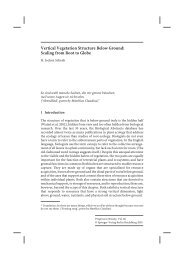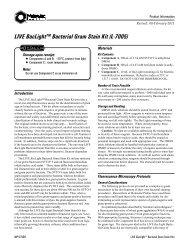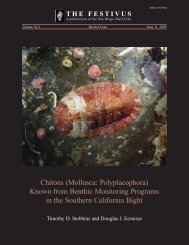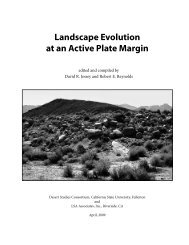2010 Overboard in the Mojave - Biological Science - California State ...
2010 Overboard in the Mojave - Biological Science - California State ...
2010 Overboard in the Mojave - Biological Science - California State ...
You also want an ePaper? Increase the reach of your titles
YUMPU automatically turns print PDFs into web optimized ePapers that Google loves.
Stop M-3. Marker beds at <strong>the</strong> Columbus/Gem m<strong>in</strong>e,<br />
overturned stratigraphy, view east. SrB: strontium and<br />
borate beds; BPL: brown platy limestone; MSL: massive<br />
stromatolitic limestone.<br />
STOP M-3—Columbus/Gem M<strong>in</strong>e. This overturned<br />
section of Barstow Formation shows, <strong>in</strong> reverse stratigraphic<br />
order, p<strong>in</strong>k 18.7 Ma tuff (PST), strontium–borate<br />
layer (SRB), three brown platy limestones (BPL), thick<br />
granitic fanglomerate, and three strata of massive cyl<strong>in</strong>drical<br />
stromatolites (MSL), <strong>the</strong> stratigraphic lowest (now<br />
<strong>the</strong> uppermost) of which is silicified. Far<strong>the</strong>r south, across<br />
a branch of <strong>the</strong> Camp Rock Fault, are aplitic granite<br />
outcrops that, when uplifted <strong>in</strong> <strong>the</strong> Daggett Ridge event,<br />
contributed to <strong>the</strong> granitic debris now found elsewhere <strong>in</strong><br />
<strong>the</strong> lower part of <strong>the</strong> stratigraphic section. Zircons from<br />
<strong>the</strong> tuff at this location are ~18.7 Ma, <strong>in</strong>dicat<strong>in</strong>g correlation<br />
with <strong>the</strong> Peach Spr<strong>in</strong>g Tuff (Miller and o<strong>the</strong>rs, this<br />
volume). This suggests that <strong>the</strong> entire ~0.8 Ma duration<br />
marker sequence at this locality is older than 18.7 Ma and<br />
started be<strong>in</strong>g deposited around 19.5 Ma. Volcaniclastic<br />
sediments between <strong>the</strong> brown platy limestones look like<br />
<strong>the</strong>ir source was <strong>the</strong> Pickhandle Formation.<br />
Stoddard Valley to <strong>the</strong> south has a similar,<br />
but abbreviated, section of marker beds, with<br />
large tubular stromatolites represent<strong>in</strong>g <strong>the</strong><br />
MSL, a s<strong>in</strong>gle BPL layer and <strong>the</strong> PST (Wells<br />
and Hillhouse, 1989; Miller and o<strong>the</strong>rs, this<br />
volume). The SrB horizon is apparently not<br />
present <strong>in</strong> Stoddard Valley. RETRACE toward<br />
powerl<strong>in</strong>e road.<br />
94.8 (0.5) TURN LEFT (west) on dirt track.<br />
95.3 (0.5) TURN LEFT (south) to avoid<br />
gully.<br />
96.2 (0.9) BEAR RIGHT (west) at Y turn.<br />
97.7 (1.5) PARK.<br />
STOP M-4—West Gem Exposures. Look<br />
east at colorful badlands exposures which <strong>in</strong>-<br />
r. e. reynolds and d. m. mller<br />
clude a p<strong>in</strong>k tuff similar to <strong>the</strong> tuff we saw at <strong>the</strong> last stop.<br />
This p<strong>in</strong>k marker tuff is useful <strong>in</strong> trac<strong>in</strong>g this portion of<br />
<strong>the</strong> stratigraphic section westward. The p<strong>in</strong>k tuff sampled<br />
at this locality has <strong>the</strong> same remnant magnetism as <strong>the</strong><br />
PST, suggest<strong>in</strong>g a correlation (Hillhouse and o<strong>the</strong>rs, this<br />
volume). Here, unlike <strong>the</strong> section at Columbus/Gem, a<br />
th<strong>in</strong> section of lacustr<strong>in</strong>e beds lie above <strong>the</strong> p<strong>in</strong>k tuff. The<br />
marker sequence is not present here, apparently due to<br />
<strong>the</strong> <strong>in</strong>flux of granitic-sourced gravels that have th<strong>in</strong> lacustr<strong>in</strong>e<br />
beds with<strong>in</strong> <strong>the</strong>m. A Pleistocene analog can be seen<br />
<strong>in</strong> Lake Manix alluvial gravel <strong>in</strong>terbedded with lacustr<strong>in</strong>e<br />
silts (Miller and Reheis, this volume).<br />
Central Daggett Ridge is visible to <strong>the</strong> west, past Ord<br />
Mounta<strong>in</strong> Road. That portion of <strong>the</strong> Miocene sedimentary<br />
section is apparently separated from this portion by a<br />
north–south fault, as <strong>the</strong> p<strong>in</strong>k tuff is not present. The central<br />
Daggett Ridge section conta<strong>in</strong>s <strong>the</strong> marker sequence<br />
(MSL, BPL and SrB <strong>in</strong> drill records of US Borax).The<br />
Daggett Ridge P/L locality (SBCM 1-109-2; Reynolds,<br />
1991) has a fauna that conta<strong>in</strong>s small and large horses<br />
suggest<strong>in</strong>g <strong>the</strong> Hem<strong>in</strong>gfordian/Barstovian transition at 16<br />
Ma, similar to <strong>the</strong> faunal transition <strong>in</strong> <strong>the</strong> Toomey Hills<br />
(next stop). Proceed northwest to power l<strong>in</strong>e road.<br />
98.0 (0.3) TURN RIGHT (north) on <strong>the</strong> section l<strong>in</strong>e<br />
road toward <strong>the</strong> power l<strong>in</strong>e road.<br />
99.0 (1.0) Stop at <strong>the</strong> power l<strong>in</strong>e road. TURN RIGHT<br />
(nor<strong>the</strong>ast) on power l<strong>in</strong>e road and retrace to Camp Rock<br />
Road.<br />
101.5 (2.5) Stop at Camp Rock Road. TURN LEFT<br />
(north) and proceed to I-40.<br />
103.5 (2.0) TURN RIGHT (north) on “A” Street and<br />
cross I-40, enter<strong>in</strong>g <strong>the</strong> town of Daggett. The arrival of <strong>the</strong><br />
Stop M-4. West Gem locality. The p<strong>in</strong>k tuff exposed here appears similar<br />
to <strong>the</strong> friable, p<strong>in</strong>k Peach Spr<strong>in</strong>g Tuff at <strong>the</strong> Columbus/Gem M<strong>in</strong>e (Stop<br />
M-3). The Tuff is overla<strong>in</strong> by a th<strong>in</strong> sequence of lacustr<strong>in</strong>e sediments.<br />
12 <strong>2010</strong> Desert Symposium
















